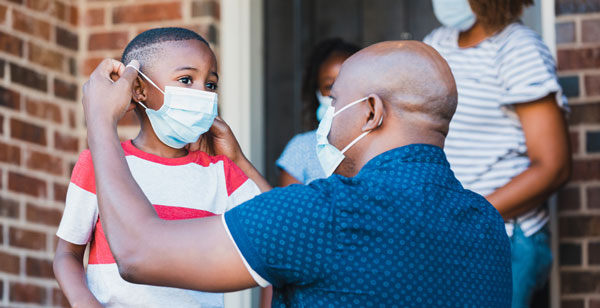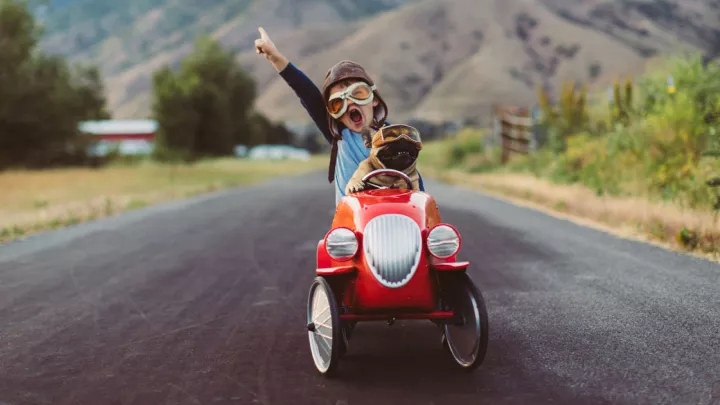
We all know that wearing a mask will help prevent the spread of COVID-19. But did you know there is a correct way to wear them? We have some tips for you on how to make sure they are as comfortable as they are safe.
To begin, it's important your mask fits snugly on your face to prevent germs from entering and leaving as you breathe in and out. To help make sure you are wearing your mask properly, we've put together some tips we use in the hospital to help you make sure you get the full benefits of wearing a mask.
1. How your mask should be worn
To get the most protection from your mask, it should be worn from the bridge of your nose to under your chin. The sides should sit flat against your cheeks with no gaps that will allow air to enter.
2. How to adjust your mask to fit better
If your mask is too big, you can shorten the ear loops to make it fit closer. Do this by tying a knot in each ear loop. Make sure the knot sits behind your ear and doesn't pull the top and bottom of the sides together, as this will open up a space for air to flow in and out.
3. If your cloth mask does not include a metal nose piece
One thing you can do is to make your own nose piece by joining several wire twist ties. Then cut a small slit on top of the band of your cloth mask and insert the ties through the small hole. When you put on your mask, adjust the wire ties so they bend to the contours of your nose.
4. If the mask is too small for your head
Tie a shoe lace or piece of string to each ear loop. Put on your mask and then tie the extended strings together at the back of your head.
5. Never criss-cross your ear loops
When you criss-cross your ear loops you may feel like the mask fits you better, but when you do this the sides of the mask where the ear loops are joined are pulled together and it results in a gap along your cheeks that germs can enter. Remember, air will go in and out through the path of least resistance. If your mask is too big, follow tip #2.
6. To alleviate pressure on the ears
Attach a paper clip or other type of clip to the ends of each loop. Then pull the loops to the back of your head and fasten together with the clips so the loops never wrap around your ears. Just make sure the straps are securing the mask to your face in the proper position. For example, if you use a device to fasten your straps together that sits on the nape of your neck, it will pull your mask downwards and away from your nose where you need the protection.
Another trick: Sew two large buttons onto the side of a cloth headband. Put on the cloth headband first. Then attach your mask loops around the buttons rather than around your ears. Just make sure the buttons are in line with your ears.
7. To prevent your glasses from fogging up
Mold the fabric up around your nose and then put your glasses over the mask.
Take some dish soap and rub it onto both sides of each lens. Then rinse off. This will leave a transparent layer that will reduce temperature changes to your lenses that cause clouding.
8. To provide additional protection against germs
Some cloth masks have a small pocket in the interior of the mask. This pocket allows you to add a filter to your mask. Since filters work best when they are made from non-woven material, use a coffee filter or a double layer of paper towel.
9. To determine if your DIY mask is effective
Hold the mask up to a light. If you can see spaces where the light shines through the fibers, it will allow particles to pass through, so it won't be effective.
10. Avoid using N95 masks with expiration valves
These N95 masks look really cool and high tech, but the reason they have a valve is to make it easier to breathe out without having to push your breath through the filter. Sounds like a great idea right? Not so fast. The problem is, people can have COVID-19 without any symptoms without knowing it. So you could be breathing out particles through the valve that can get others sick.
11. To make your facial recognition software recognize you with a mask
Go to the face ID settings in your phone and click on "set up an alternate appearance." Then fold your face mask in half and hold it over one side of your face while your phone scans you. Repeat for the other side.
12. If you don’t have a child’s mask for your child
Follow tip #2 to shorten the straps to make the mask. It is okay if the mask covers more of their face, as long as it is sitting snug and not interfering with their vision.
13. If you can’t attach the mask loops behind your ears because you wear a hijab, try one of these three mask modifications
- Put the mask on over the hijab and attach the loops together in the back with a safety pin or paper clip.
- Loop an additional string through the loops and tie together in the back.
- Sew two large buttons onto the side of a cloth headband. Put on the cloth headband first. Then attach your mask loops around the buttons rather than around your ears.
14. How to properly dispose of your face mask
COVID-19 germs can spread when masks are not disposed of properly. When they end up on our beaches and get washed up into the ocean, they can create problems for sea creatures that may mistake them for a food source. Sea animals can get tangled up in the masks or swallow the masks, causing digestive problems.
- Remove your mask by the elastic bands. Fold in half, touching only the sides of your mask to avoid touching any germs on the front
- Throw single use masks into a trash can, if one is available
- If there is a chance your mask could end up in sea waters, cut the strings before you put it into a trash can
- If a trash can is not available, you can leave the mask in your care for 24 hours, before disposing of it to allow the germs to die
- Do not recycle masks as they can become entangled in the recycling machinery and they may infect the sanitation workers at the recycling plant
- Wash hands with soap and water or use an alcohol-based hand rub after disposing of your mask
- If using a cloth mask, wash it
15. If you will be using your mask again
- It is okay to reuse your mask, so long as you have taken care to not let the inside get contaminated
- When we wear our masks, moisture from our breath causes them to get damp. That's why it is advised to place your worn mask in a breathable container such as a paper bag. If you're in your car, you can hang it on something to let it dry. Do not hang it from your rear view mirror, as that can obstruct your view of the road
How masks are designed for your safety
Health care providers wear surgical masks to prevent the transmission of infectious diseases such as COVID-19. Surgical masks are generally constructed of a material that is comprised of three layers. The outer layer is fluid impermeable to prevent droplets penetrating the mask. The middle layer is a non-woven filter material that prevents particles getting to the inside of the mask, and the inner layer is a moisture-wicking layer to absorb the moisture in our breath and make wearing the mask more comfortable. The three layers are sewn together, which makes it appear there is only one layer.
When the masks are constructed, the three-ply material is pleated with all the pleats facing downwards. This is known as the waterfall effect or cascade pleat.
The downward facing pleat is an important safety feature of the mask, because it doesn’t allow particles to rest on the fold that creates the pleat. When the pleat faces upwards, the fold in the pleats act like ledges for particles to rest upon. Never flip your mask upside down because that would result in the pleats facing upwards which will allow particles to rest on the mask.
Don't do these things while wearing a mask
- Don't touch the outside of the mask because this can cause your hands to get contaminated, or you may carry germs to your mask by your hands
- Don't wear your mask under your chin for two reasons. First, you may cause germs from the outside of your mask to get onto your skin. And second, if your mask has germs on it, you will be breathing air that is close to your mask
- Don't move your mask away from your mouth to talk because this will cause you to breathe in and out unprotected
- Don't move your mask to drink or eat unless you have removed your mask properly and put it somewhere safe



